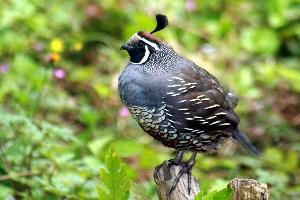
Súlyok és méretek
| Marmagasság | 20-tól 25-ig cm |
|---|---|
| Súly | 140-tól 170-ig g |
Biológiai adatok
| Élettartam | 1-tól 5-ig éves |
|---|
Veszélyeztetettség
| Veszélyeztetett |
Állatleírás
The Northern bobwhite, scientifically known as Colinus virginianus, is a small ground-dwelling bird native to the United States, Mexico, and the Caribbean. This species is a member of the New World quail family and is recognized for its distinctive call, which sounds like a clear whistle of "bob-white" or "bob-bob-white." The Northern bobwhite plays a significant role in its ecosystem, serving as both a predator of insects and seeds and prey for larger animals.Adult Northern bobwhites are characterized by their round body, short tail, and relatively small size, typically measuring between 9.8 to 11 inches in length and weighing between 5.6 to 6.7 ounces. Males and females exhibit sexual dimorphism, meaning they can be distinguished by their appearance. Males have strikingly patterned black and white faces, with rich brown and white plumage and a white throat bordered by black. Females, on the other hand, display more subdued colors, with a buff throat and eye stripe, and overall less contrasting plumage than the males.
These birds possess strong legs and feet, adapted for their primarily ground-dwelling lifestyle. They are adept at walking and running through dense underbrush to forage for their diet, which mainly consists of seeds, grains, and insects. During the spring and summer, insects become a more significant part of their diet, especially for chicks, providing the necessary protein for growth.
Northern bobwhites are known for their complex social structures and behaviors. Outside of the breeding season, they form coveys, which are groups that can number more than a dozen birds, providing safety in numbers from predators. These coveys break up during the breeding season, as males and females pair off to nest and raise their young. The nesting process involves the female laying a clutch of 12-16 eggs, which she incubates for about 23 days. Both parents participate in rearing the young, who are precocial and able to leave the nest shortly after hatching to forage for food.
The habitat of the Northern bobwhite is diverse, ranging from grasslands, agricultural fields, and open pine forests to mixed woodland areas. They are highly adaptable but require areas with dense underbrush for cover and nesting. Unfortunately, their populations have been in decline due to habitat loss, changes in agricultural practices, and the use of pesticides which reduce their food sources.
Conservation efforts are in place to protect and restore the Northern bobwhite's habitat, including controlled burning, planting native grasses, and creating buffer zones around agricultural fields. These measures aim to increase the bobwhite population and maintain the ecological balance in their native regions.
In summary, the Northern bobwhite (Colinus virginianus) is a fascinating and important bird species with distinctive characteristics and behaviors. Despite facing challenges from habitat loss and environmental changes, efforts to conserve and protect their populations continue, highlighting the importance of this species to biodiversity and ecosystem health.
Hasonló állatok
Új állatfotók
Top 10 állat
- Dolphin gull (Leucophaeus scoresbii)
- Japanese macaque (Macaca fuscata)
- Stone loach (Barbatula barbatula)
- Galápagos tortoise (Geochelone nigra complex)
- Russian tortoise (Testudo horsfieldii)
- Diana monkey (Cercopithecus diana)
- Greek tortoise (Testudo graeca)
- Common flying dragon (Draco volans)
- Moustached guenon (Cercopithecus cephus)
- Galápagos penguin (Spheniscus mendiculus)
